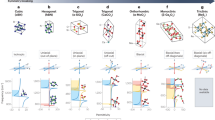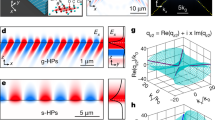Abstract
Various optical crystals possess permittivity components of opposite signs along different principal directions in the mid-infrared regime, exhibiting exotic anisotropic phonon resonances. Such materials with hyperbolic polaritons—hybrid light–matter quasiparticles with open isofrequency contours—feature large-momenta optical modes and wave confinement that make them promising for nanophotonic on-chip technologies. So far, hyperbolic polaritons have been observed and characterized in crystals with high symmetry including hexagonal (boron nitride), trigonal (calcite) and orthorhombic (α-MoO3 or α-V2O5) crystals, where they obey certain propagation patterns. However, lower-symmetry materials such as monoclinic crystals were recently demonstrated to offer richer opportunities for polaritonic phenomena. Here, using scanning near-field optical microscopy, we report the direct real-space nanoscale imaging of symmetry-broken hyperbolic phonon polaritons in monoclinic CdWO4 crystals, and showcase inherently asymmetric polariton excitation and propagation associated with the nanoscale shear phenomena. We also introduce a quantitative theoretical model to describe these polaritons that leads to schemes to enhance crystal asymmetry via the damping loss of phonon modes. Ultimately, our findings show that polaritonic nanophotonics is attainable using natural materials with low symmetry, favouring a versatile and general way to manipulate light at the nanoscale.
This is a preview of subscription content, access via your institution
Access options
Access Nature and 54 other Nature Portfolio journals
Get Nature+, our best-value online-access subscription
$29.99 / 30 days
cancel any time
Subscribe to this journal
Receive 12 print issues and online access
$259.00 per year
only $21.58 per issue
Buy this article
- Purchase on Springer Link
- Instant access to full article PDF
Prices may be subject to local taxes which are calculated during checkout




Similar content being viewed by others
Data availability
All data are available in the Article or Supplementary Information.
References
Born, M. & Wolf, E. Principles of Optics 5th edn, 333–334 (Pergamon, 1975).
Caldwell, J. D. et al. Low-loss, infrared and terahertz nanophotonics using surface phonon polaritons. Nanophotonics 4, 44–68 (2015).
Basov, D. N., Fogler, M. M. & García de Abajo, F. J. Polaritons in van der Waals materials. Science 354, aag1992 (2016).
Low, T. et al. Polaritons in layered two-dimensional materials. Nat. Mater. 16, 182–194 (2017).
Hu, G., Shen, J., Qiu, C.-W., Alù, A. & Dai, S. Phonon polaritons and hyperbolic response in van der Waals materials. Adv. Opt. Mater. 8, 1901393 (2020).
Zhang, Q. et al. Interface nano-optics with van der Waals polaritons. Nature 597, 187–195 (2021).
Dai, S. et al. Tunable phonon polaritons in atomically thin van der Waals crystals of boron nitride. Science 343, 1125–1129 (2014).
Caldwell, J. D. et al. Sub-diffractional volume-confined polaritons in the natural hyperbolic material hexagonal boron nitride. Nat. Commun. 5, 5221 (2014).
Li, P. et al. Hyperbolic phonon-polaritons in boron nitride for near-field optical imaging and focusing. Nat. Commun. 6, 7507 (2015).
Zheng, Z. et al. Highly confined and tunable hyperbolic phonon polaritons in van der Waals semiconducting transition metal oxides. Adv. Mater. 30, e1705318 (2018).
Ma, W. et al. In-plane anisotropic and ultra-low-loss polaritons in a natural van der Waals crystal. Nature 562, 557–562 (2018).
Hu, G. et al. Topological polaritons and photonic magic angles in twisted α-MoO3 bilayers. Nature 582, 209–213 (2020).
Duan, J. et al. Twisted nano-optics: manipulating light at the nanoscale with twisted phonon polaritonic slabs. Nano Lett. 20, 5323–5329 (2020).
Zheng, Z. et al. Phonon polaritons in twisted double-layers of hyperbolic van der Waals crystals. Nano Lett. 20, 5301–5308 (2020).
Taboada-Gutiérrez, J. et al. Broad spectral tuning of ultra-low-loss polaritons in a van der Waals crystal by intercalation. Nat. Mater. 19, 964–968 (2020).
Ma, W. et al. Ghost hyperbolic surface polaritons in bulk anisotropic crystals. Nature 596, 362–366 (2021).
Schubert, M. et al. Anisotropy, phonon modes, and free charge carrier parameters in monoclinic β-gallium oxide single crystals. Phys. Rev. B 93, 125209 (2016).
Passler, N. et al. Hyperbolic shear polaritons in low-symmetry crystals. Nature 602, 595–600 (2022).
Giles, A. J. et al. Ultralow-loss polaritons in isotopically pure boron nitride. Nat. Mater. 17, 134–139 (2018).
Lee, I.-H. et al. Image polaritons in boron nitride for extreme polariton confinement with low losses. Nat. Commun. 11, 3649 (2020).
Ambrosio, A. et al. Selective excitation and imaging of ultraslow phonon polaritons in thin hexagonal boron nitride crystals. Light Sci. Appl. 7, 27 (2018).
Li, P. et al. Infrared hyperbolic metasurface based on nanostructured van der Waals materials. Science 359, 892–896 (2018).
Li, P. et al. Collective near-field coupling and nonlocal phenomena in infrared-phononic metasurfaces for nano-light canalization. Nat. Commun. 11, 3663 (2020).
Tielrooij, K.-J. et al. Out-of-plane heat transfer in van der Waals stacks through electron–hyperbolic phonon coupling. Nat. Nanotechnol. 13, 41–46 (2018).
Autore, M. et al. Boron nitride nanoresonators for phonon-enhanced molecular vibrational spectroscopy at the strong coupling limit. Light Sci. Appl. 7, 17172 (2018).
Bylinkin, A. et al. Real-space observation of vibrational strong coupling between propagating phonon polaritons and organic molecules. Nat. Photon. 15, 197–202 (2021).
Feres, F. H. et al. Sub-diffractional cavity modes of terahertz hyperbolic phonon polaritons in tin oxide. Nat. Commun. 12, 1995 (2021).
Castilla, S. et al. Plasmonic antenna coupling to hyperbolic phonon-polaritons for sensitive and fast mid-infrared photodetection with graphene. Nat. Commun. 11, 4872 (2020).
Kittel, C., McEuen, P. & McEuen, P. Introduction to Solid State Physics Vol. 8 (Wiley, 1996).
Landau, L. et al. Electrodynamics of Continuous Media Vol. 8 (Elsevier, 2013).
Gillette, R. H. Calcium and cadmium tungstate as a scintillation counter crystal for gamma-ray detection. Rev. Sci. Instrum. 21, 294–301 (1950).
Mock, A., Korlacki, R., Knight, S. & Schubert, M. Anisotropy, phonon modes, and lattice anharmonicity from dielectric function tensor analysis of monoclinic cadmium tungstate. Phys. Rev. B 95, 165202 (2017).
Huber, A., Ocelic, N. & Hillenbrand, R. Local excitation and interference of surface phonon polaritons studied by near‐field infrared microscopy. J. Microsc. 229, 389–395 (2008).
Lee, D. et al. Hyperbolic metamaterials: fusing artificial structures to natural 2D materials. eLight 2, 1 (2022).
Ocelic, N., Huber, A. & Hillenbrand, R. Pseudoheterodyne detection for background-free near-field spectroscopy. Appl. Phys. Lett. 89, 101124 (2006).
Acknowledgements
C.-W.Q. acknowledges support from the National Research Foundation, Prime Minister’s Office, Singapore, under its Competitive Research Programme (CRP award NRF CRP22-2019-0006) and from the grant (A-0005947−16-00) from Advanced Research and Technology Innovation Centre (ARTIC). Q.D. acknowledges support from the National Natural Science Foundation of China (grant no. 51925203). D.H. acknowledges support from the National Natural Science Foundation of China (grant no. 52072083). J.D.C. acknowledges financial support from the US National Science Foundation (grant no. 2128240). J.W. acknowledges the Advanced Manufacturing and Engineering Young Individual Research Grant (AME YIRG grant no. A2084c170) and SERC Central Research Fund (CRF). P.L. acknowledges support from the National Natural Science Foundation of China (grant no. 62075070). W.M. acknowledges support from the Fundamental Research Funds for the Central Universities, HUST (grant no. 2022JYCXJJ009). A.A. and X.N. were supported by the Air Force Office of Scientific Research, the Office of Naval Research and the Simons Foundation.
Author information
Authors and Affiliations
Contributions
C.-W.Q, P.L. and A.A. conceived the idea. G.H. and W.M. performed the theory, simulation and design, with substantial input from C.-W.Q. and A.A. D.H. measured the sample with supervision by P.L. and Q.D. X.D.Z. fabricated the Au nanoantenna. G.H., W.M., X.L.Z., J.C., A.P., Q.D., A.A., P.L. and C.W. analysed the data, with input from all the authors. G.H., W.M. and D.H. wrote the manuscript with substantial contributions from all the others. C.-W.Q. oversaw the project.
Corresponding authors
Ethics declarations
Competing interests
The authors declare no competing interests.
Peer review
Peer review information
Nature Nanotechnology thanks the anonymous reviewers for their contribution to the peer review of this work.
Additional information
Publisher’s note Springer Nature remains neutral with regard to jurisdictional claims in published maps and institutional affiliations.
Supplementary information
Supplementary Information
Supplementary Sections 1–3 and Figs. 1–9.
Rights and permissions
Springer Nature or its licensor (e.g. a society or other partner) holds exclusive rights to this article under a publishing agreement with the author(s) or other rightsholder(s); author self-archiving of the accepted manuscript version of this article is solely governed by the terms of such publishing agreement and applicable law.
About this article
Cite this article
Hu, G., Ma, W., Hu, D. et al. Real-space nanoimaging of hyperbolic shear polaritons in a monoclinic crystal. Nat. Nanotechnol. 18, 64–70 (2023). https://doi.org/10.1038/s41565-022-01264-4
Received:
Accepted:
Published:
Issue Date:
DOI: https://doi.org/10.1038/s41565-022-01264-4
This article is cited by
-
Observation of naturally canalized phonon polaritons in LiV2O5 thin layers
Nature Communications (2024)
-
Van der Waals quaternary oxides for tunable low-loss anisotropic polaritonics
Nature Nanotechnology (2024)
-
Manipulating hyperbolic transient plasmons in a layered semiconductor
Nature Communications (2024)
-
Planar hyperbolic polaritons in 2D van der Waals materials
Nature Communications (2024)
-
Wandering principal optical axes in van der Waals triclinic materials
Nature Communications (2024)



